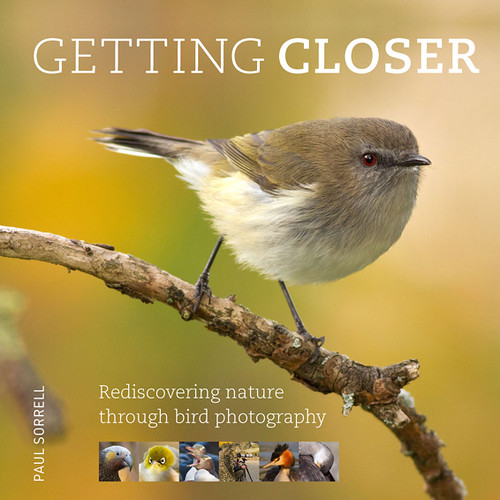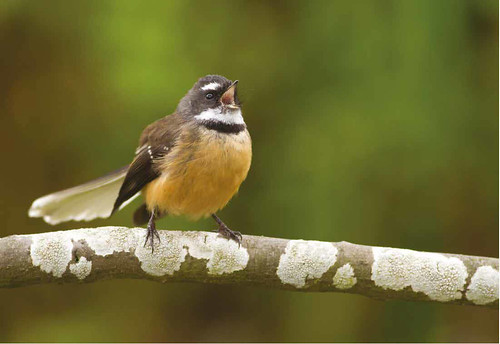Renowned photographer Paul Sorrell has a new book out, entitled Getting Closer: Rediscovering nature through bird photography. In this fascinating book, he details ways to best photograph birds and other wildlife.

The entire book is both inspiring and a great read! Sections include Encountering the Great Outdoors, Making the Shot, The Bigger Picture, and Tools of the Trade. I'll never look at birds—and photographing them—the same way. Sorrell notes,
My aim in this book is to pass on the knowledge and fieldcraft techniques that I’ve accumulated as a photographer and nature lover (I’m not sure which comes first) to help readers achieve a connection with wild places that is sorely needed in this time of ecological crisis and widespread despair about the future of our planet. I’ve found that intimacy with nature can bring not only understanding, but also joy.
Whether you're an old hand at photographing birds, or eager to get started (especially now!), it's an excellent read. Highly, highly recommended!
We were lucky enough to publish an excerpt of Getting Closer. This chapter is entitled In Your Own Backyard.
Sometimes, when I show people an image I’ve taken recently, they might exclaim, ‘What a great shot!’ And I might reply, perhaps a little too smugly, ‘I shot it from my bedroom window—I didn’t even have to leave the house.’

A pied fantail sings its heart out in my back garden.
Camera: Canon EOS 7D. Lens: EF400mm f/5.6L USM.
Settings: 400mm ƒ/5.6 1/250 sec ISO 800. © Paul Sorrell
Creating a suitable place to photograph wild birds around your home is a great first step for the budding wildlife photographer. Such a move has many advantages. First, with a little planning you can create an environment that comes closer than anything else to an outdoor studio (see pp. 30–33). Second, it can be as simple or as elaborate as you care to make it. And, finally, because there’s no need for you to leave home, you can use your setup anytime the mood takes you.
In my case, I’m lucky that my setup comes ready-made in the shape of a native kōwhai tree on the lawn behind my 1908 wooden villa in the suburbs. By standing on the veranda, or setting up my tripod in the bedroom and shooting through the sash windows, I can focus on a variety of attractive lichen-encrusted branches and twigs where I hope my avian subjects will settle. Shooting from indoors is the ultimate in comfort—you can even pull up an easy chair …
Having arranged your ‘studio’, the next challenge is to attract your quarry. Here there are a variety of approaches. Sometimes I use playback, with the speaker sitting close to my target perch, or I use food as bait. In New Zealand, a simple container of sugar-water will attract our three native honeyeaters: tūī, bellbirds and silvereyes. More elaborate feeders offering fat, seeds and nuts will draw a variety of small birds including finches and (in Europe, for example) warblers and woodpeckers.

This blackbird collected many beakfuls of worms and insects for its young as I spread compost on my vegetable plot.
Camera: Canon EOS 50D. Lens:
EF400mm f/5.6L USM. Settings: 400mm
ƒ/6.3 1/60 sec ISO 400. © Paul Sorrell
If your garden lacks suitable natural perches, then you can easily make your own setup. This might be as simple as a couple of stakes driven into the ground, one holding a feeder and the other with a photogenic branch or foliage attached. Arrange the perch so that hungry birds will alight on it—albeit briefly—before proceeding to the feeder. Position your feeding station close to a place that offers some concealment, such as a garden shed. And be aware of the background and direction of the light—you can often change your position to get the result you want.

This grey warbler was photographed from my bedroom window.
Camera: Canon EOS 7D. Lens: EF400mm
f/5.6L USM. Settings: 400mm ƒ/5.6 1/320 sec
ISO 800. © Paul Sorrell
HANDY HACK
Autumn leaves can be used in at least two ways: as part of the foreground, adding texture and shape as well as bold colour; or (if sufficiently distant) to provide an orange–red blur that will provide your subject with an attractive backdrop.

Distant autumn leaves provide a colourful backdrop for a pair of silvereyes in my backyard.
Camera: Canon EOS 7D. Lens: EF400mm f/5.6L USM.
Settings: 400mm ƒ/5.6 1/250 sec ISO 800. © Paul Sorrell
TOP TIP
Once you have found a suitable perch–well lit, with attractive bokeh (out-of-focus highlights) or interesting foliage–in a spot where the birds are active, don’t be tempted to shift your lens onto another target, even if you have to wait a while. Unless of course something extraordinary is happening on the next-door-twig. One way to maximize your changes is to keep both eyes open as you peer through the viewfinder.
About the Author
Paul Sorrell took up photography in the early 2000s, giving him a new form of creative engagement with his longstanding interest in wildlife and the natural world. His images have featured in local, national and international wildlife photography competitions, and he has published online and print pieces for outlets ranging from airline magazines to Tourism New Zealand's website and the School Journal. He has worked in the area of books and publishing since the 1980s, copy-editing, writing for academic and popular journals, and publishing four books about his home province of Otago with Penguin Random House.
Find Paul online at https://www.paulsorrell.co.nz/
Find his book on Amazon: https://amzn.to/3oYO2Hh
All material contained herein courtesy and copyright Paul Sorrell, reprinted with permission.
